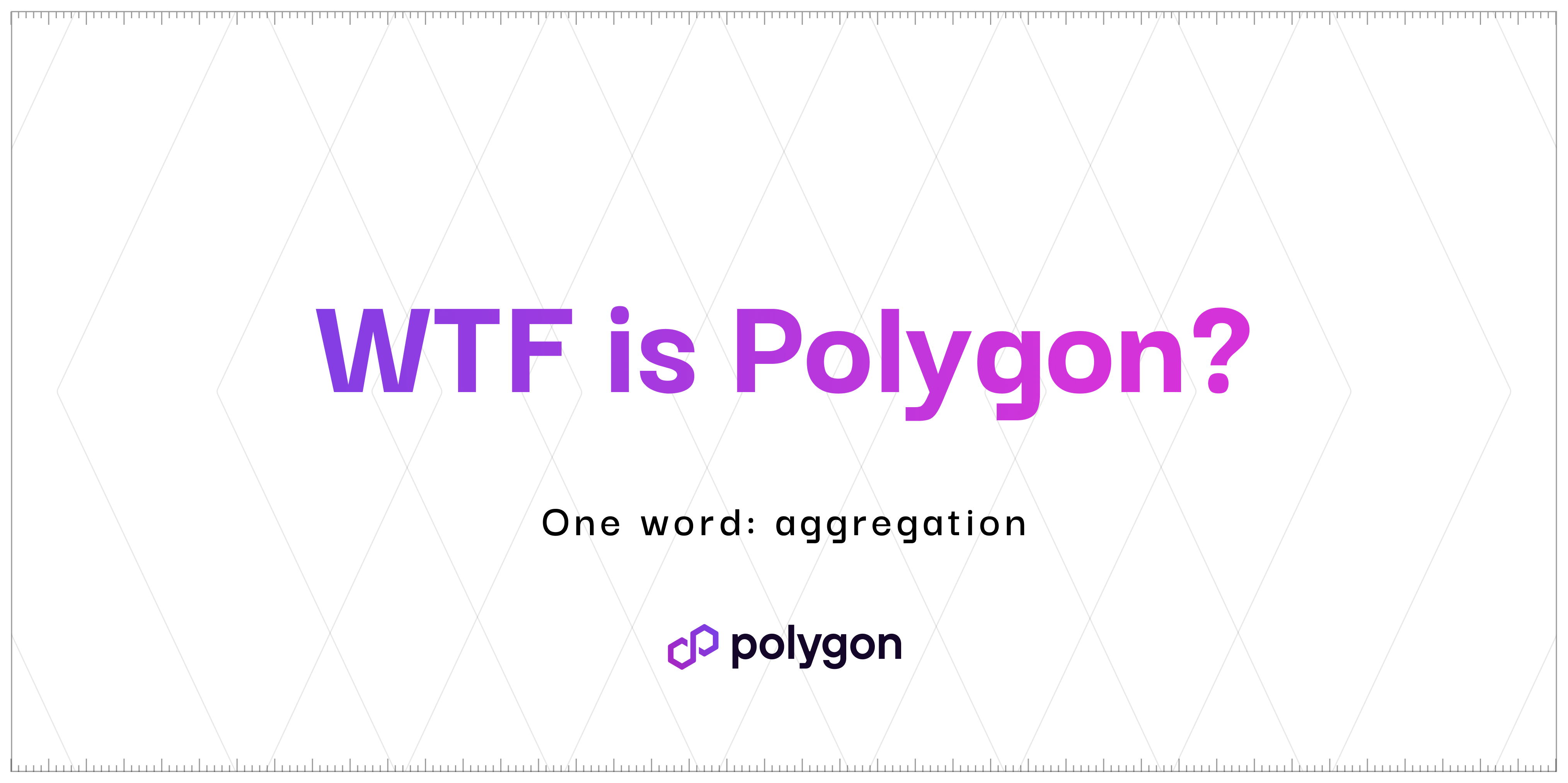WTF is Polygon?
One word: aggregation

tl;dr
- Polygon = A global network of aggregated blockchains
- AggLayer = A horizontally scalable multichain network that enables access to shared liquidity and state across sovereign, connected chains
- Polygon CDK = Empowers devs to launch sovereign, interconnected ZK L2s, or connect existing L1s to the AggLayer
- All powered by next gen ZK proving tech for performance and security
Honesty time: When most people think of “Polygon,” they think of the Polygon Proof-of-Stake (PoS) sidechain.
And, for a lot of reasons, this isn’t a bad thing! Thanks to an ecstatic community of users and devs, Polygon PoS is one of the most widely-used and built-upon blockchains in the world. Lately, it’s been cooking: Unique addresses surged by 91% in 2023, according to some analyses, leading to daily active addresses hitting an all time high of 1.3 million in early April, 2024. Low cost, super fast, with an extremely robust network of dApps, dev tooling, centralized exchange connections, and more – Polygon PoS is a flourishing, technically powerful, and eco-friendly network.
But after the bleeding-edge zero-knowledge research of the last two years by core developers at Polygon Labs—and rigorous community discussions, contributions, and feedback—it’s simply not accurate to say that “Polygon” is only Polygon PoS.
Now, Polygon can be summed up in one word: Aggregation.
This post introduces a new mental model: Polygon is the first aggregated blockchain network, an elastically scalable web of sovereign chains, where state and liquidity are shared among all.
As an evolution that synthesizes the best of monolithic and modular blockchain design, new chains can be spun up to meet demand, or existing chains can join and interoperate seamlessly, in a unified environment. Composability means developers tap users across all connected protocols, rather than building only on a single chain.
This results in practically unlimited capacity, better network effects, faster finality, and more security than other existing chain designs.

For Polygon to become an aggregated blockchain network, a few key elements must work in tandem:
- AggLayer, for unified liquidity: A protocol that unifies liquidity across a multi-chain network by aggregating proofs from all connected chains, and ensuring safety for near-instant, atomic cross-chain transactions.
- Polygon CDK, for unlimited scale: A modular, open source collection of tools that allows developers to deploy their own sovereign ZK-powered L2, or permits existing L1 and L2 chains to migrate to the AggLayer. Sovereign, always.
- Upgrading to the next generation of proving tech, starting with a Type 1 mode: Ongoing innovations in generating ZK proofs, including a Type 1 mode that can prove Ethereum blocks, which will lead to faster, cheaper ZK proofs for better dev and user experience–and lays the foundation for migrating Polygon PoS to become a zkEVM validium.
Let’s dive into what all this means.
Define aggregated
Here’s our definition: a horizontally scalable multichain network that enables access to shared liquidity and state across sovereign, connected chains.
Let’s put this in context.
Until now, there have been two primary approaches to blockchain design: monolithic architectures, unified and interoperable by design, where chains run nodes responsible for consensus, data availability, and execution, and serve as a settlement layer; and modular architectures, resulting in many chains running independently and in parallel, each maintaining sovereignty.
Both paradigms have their upsides and tradeoffs. Monoliths allow for unity, and a better user experience, but often at the expense of sovereignty and true global scalability. Modular architectures, by contrast, tackle these problems, but in doing so, fracture state and liquidity by creating moats from chain to chain, introducing bad user experience and new security risks in cross-chain bridging.
Aggregated blockchains synthesize these approaches, combining the best of each.
With aggregated chains, developers and users find the sovereignty and scale of modular architectures, as well as the unified liquidity and UX of a monolithic system, synthesizing two approaches into something novel.
In the context of the AggLayer, it connects disparate chains together, allowing for fast, secure chain-to-chain transactions and communication.
By aggregating liquidity and security guarantees, the AggLayer solves one of crypto’s major UX problems: How to make a bunch of sovereign blockchains feel like using the Internet as we know it.
AggLayer, for unified liquidity
The Aggregation Layer, or the AggLayer, is the first aggregated blockchain network. It is a neutral, decentralized service that will accept proofs from all connected chains, verify chain states are consistent, aggregate these proofs, and then settle them to Ethereum.
In essence, the AggLayer enables two things:
- It aggregates proofs from all connected chains.
- It allows for safe cross-chain coordination at lower-than-Ethereum latency.
Fundamentally, the AggLayer will be a simple, cryptographically enforced service which allows different chains, with different execution environments, to safely interoperate. Chains will be able to accept messages or bundles from other chains at a lower-than-Ethereum latency by leveraging the cold, hard math of ZK proofs.
In doing so, the AggLayer enables the first aggregated blockchain network—a web of chains.
As opposed to other “multichain” networks, the AggLayer depends on a single, unified bridge to Ethereum.
From the perspective of Ethereum, all rollups are smart contracts that hold a state root with a bunch of assets, plus a verifier that says what can go in and out.
But suppose a user on an L2 chain wants to transact with another chain. They have two choices. They can withdraw assets to Ethereum and bridge to a different L2 in this way—which is cumbersome, or in the case of optimistic proofs, requires a seven-day delay; or they can use third-party bridging services, which mint synthetic tokens on destination chains and rely on additional trust assumptions.
Aggregated blockchains offer a third solution—that of shared state and liquidity.
In the AggLayer design, only a single bridge contract on Ethereum exists for all connected chains. Where we see a multiplicity, Ethereum will see a single contract.
Each chain will have a local copy of the unified bridge root, enabling cross-chain transactions that don’t require withdrawing to Ethereum or the security risks of third-party bridges. Because all connected chains will share a unified bridge (which is already live), the AggLayer enables asset fungibility.
So if a user on Polygon zkEVM wants to send POL to a user on Astar zkEVM, they will be able to send native POL, rather than a synthetic version that is wrapped or local to Astar zkEVM.
Native tokens can be moved through the unified bridge and come out still as a native token on any other chain.
For now, however, only the first components of the AggLayer are live—and the first protocol, Astar zkEVM, connected in March 2024.
These are big steps, but they are just the beginning.
For a nerdsnipe deep-dive into the fundamental logic and architecture of the emerging AggLayer, read Polygon Labs'cofounder Brendan Farmer’s post on Mirror.
Polygon CDK, for elastic scalability

Polygon CDK is a modular, open source software toolkit for blockchain developers. It empowers developers to launch new L2 chains on Ethereum or, with the Type 1 prover, transition existing Layer 1 (L1) chains into L2s.
Modularity means that CDK supports the installation and configuration of a variety of chain architectures, operating under the philosophy of chain sovereignty.
What a chain should look like should be left up to devs.
With Polygon CDK, developers can tailor a chain’s architecture specific to its needs from a set of supported, open source components. As an example, developers can select between rollup or validium mode. Rollups post transaction data from their chain directly onto Ethereum whereas validiums only post the transaction hash. In addition to choosing from supported components, developers can integrate custom components for (very) specific requirements.
There are already a ton of projects building with or testing Polygon CDK, including Astar, Immutable, Gnosis Pay, Libre, Hypr, Canto, Palm Network, IDEX, and many, many more.
Next gen upgrade to the zkEVM prover, with Type 1 mode

Recently, developers at Polygon Labs announced an upgrade to the zkEVM prover for Polygon protocols as the next generation of proving tech, made possible with contributions from core researchers at Toposware.
This upgrade supports a highly performant Type 1 mode, which is Ethereum equivalent, dual licensed under MIT and Apache 2.0, and available on GitHub. The Type 1 is revolutionary on two fronts:
- Type 1 allows any existing EVM chain to become a ZK L2 and, in the future, connect to the AggLayer. This is a foundational step toward migrating Polygon PoS to become a ZK L2.
- Type 1 proves mainnet Ethereum blocks themselves, at an average cost of $0.002-$0.003 per transaction, as of the publication of this post.
With Plonky3 and additional optimizations to the Type 1 zkEVM prover, expect a 30 to 50X reduction in cost over the next year. This next-gen zkEVM prover will bring lower costs, lower latency, and a better user experience to chains built with Polygon CDK.
For a deeper technical look, check out this post on Toposware’s blog.
So, what does an aggregated blockchain network mean for developers and users?
At a high level, the AggLayer will enable near-instant atomic transactions, unify liquidity across the ecosystem, create better capital efficiency, and dramatically improve UX.
Coupled with Polygon CDK, Polygon becomes an endlessly elastic, unified network, where new chains can be spun up and launched on demand, or existing EVM L1 chains can migrate and connect to the AggLayer. Here’s what that means:
For L1s and L2s connected to AggLayer
- Tap cross-chain unified liquidity.
- Reach users in aggregate.
- Maintain full sovereignty over how to design and implement chains.
- Design utility tokens for gas, validator rewards, etc.
- A better bridge to Ethereum.
For dApp developers
- Reach users in aggregate.
- Tap cross-chain unified liquidity.
- Even if a dApp is on another chain, users from all chains will be able to interact with it, without cumbersome bridging UX.
- Where chains deploy coordination mechanisms like shared sequencing, enjoy near-instant cross-chain atomic transactions, which mean true growth and access to users of the aggregated network.
For end users
- UX that feels like the Internet. A single environment that doesn’t require cumbersome and frequent bridging.
- In the end state of AggLayer, end users will be able to execute cross-chain transactions extremely fast.
- Enhanced security for users
Are you a developer, and want to learn more? There are a ton of resources to consult:
- For dApp developers, check out protocol documentation, and decide what chain is right for you: Polygon PoS, Polygon zkEVM, or (forthcoming) Polygon Miden.
- For chain builders, read the CDK technical documentation.
- For future-forward thinkers, read the AggLayer docs (in development) or take a deep dive.
- Finally, join the forum and ask all burning questions.
And make sure to tune into the blog and social channels to keep up with updates about Polygon technology.
Website | Twitter | Forum | Telegram | Discord | Instagram | LinkedIn | Polygon Knowledge Layer










.png)





.png)
